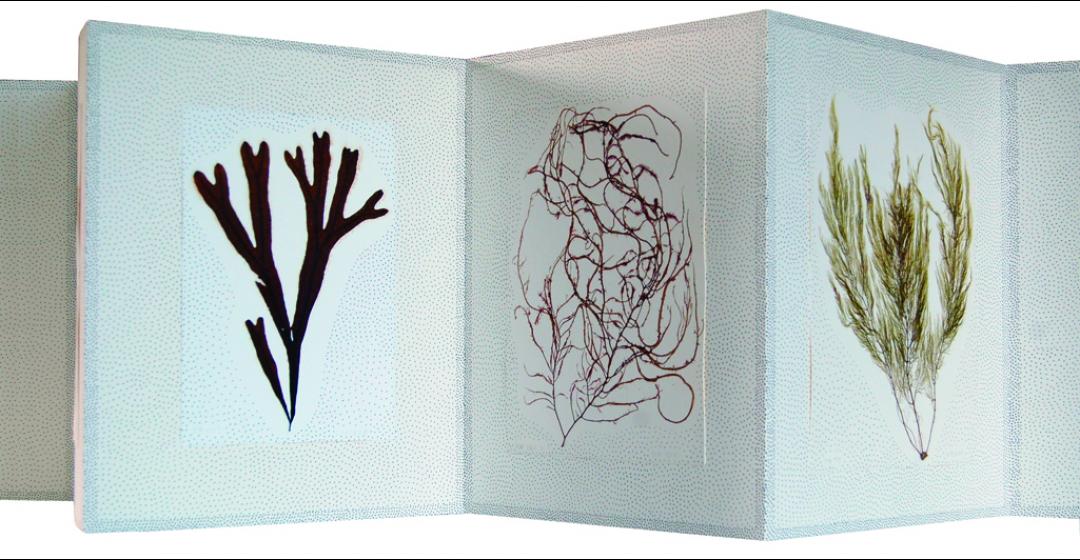An avid accumulator of nature’s ephemera, artist Lucy Mitchell operates like a nineteenth-century naturalist. She preserves and archives the fragments of flora and fauna she picks up along her walks, filling neatly labeled drawers and boxes and shelves in her West Tisbury barn studio.
When a creative idea takes hold, she plumbs the depths of her stockpile, meticulously arranging and detailing and perfecting for days and sometimes weeks on end. Though she shows her work less frequently than some of her fellow well-known Vineyard artists – including her husband, painter Rez Williams – this month her latest pieces are on display at the West Tisbury Free Public Library. A series of long, horizontal, accordion-fold assemblages, the pieces reveal something of the essence of her longtime Island life, which goes back to early childhood summers spent exploring the West Tisbury woods and north shore.
“The bits and pieces I’ve included in this work are all part of a collection of pressings that I’ve made over time,” she says. “A lot of my work has to do with nature, and embellishing it. I love illuminating natural things, in this case leaves and seaweed and wasp nest paper. They’re perfect for a project like this.”
Mitchell’s eclectic appetite for books informs and inspires her art, she says, so the library is a particularly apt venue. She’s a fan of the late John Mortimer’s Rumpole of the Bailey series, and of novelist Kate Atkinson. She also loves the writing of the Japanese novelist Haruki Murakami, about whom one reviewer said “his works are built around an almost obsessive urge to explore and understand the inner core of the human identity.” One might say Mitchell takes a similar approach to her own work, as she circles deep into the layers of nature’s minutiae.
“Years ago, I did a series of small bound books, incorporating postage stamps,” says Mitchell, who has also covered cast-off wood scraps with paper collage; lined up on a shelf together, they look like book volumes. “I’ve also been prompted by those faint, ruled lines you see in illuminated manuscripts, to do drawings using invented scripts on penciled lines.”
This time, however, her creativity manifested itself in the accordion style favored by long-ago Asian bookbinders. Each piece has a theme: seaweed, sassafras leaves, wasp nest paper, dictionary pages. Apart from the last, these books have no words, but within “Wasp Papers,” she drew circles of ink marks that resemble cuneiform text, alternating with pages of pressed wasp nest fragments.
“It looks like something a bee might do, if a bee was writing text,” Mitchell says. “It follows an orderly progression, like how bees might construct their hives.”
The accordion nature of the work on display, mounted on a hidden foamcore framework, enhances its illuminative quality, allowing light behind the opaque paper to cast a subtle glow along its folds. They range in length from two to twelve feet, though when fully stretched out off the framework, they’re even longer.
“Sassafras Album” incorporates dried, pressed sassafras leaves, arranged by size from a tiny, half-inch leaflet to a palm-sized sassafras mitten. Mitchell is, as ever, particular about details, evidenced by her intricately painted background patterns, the white photo corners that attach each leaf collage to the thick cotton paper, and the stainless steel insect-mounting pins that hold the accordion folds so precisely. “Wasp Papers” and “Seaweed Album,” with their delicate pinpoints of ink that shadow and frame each page, are similarly constructed. “Dictionary Pages – A” features Mitchell’s characteristic abstract pattern that resembles undulating amoebae, painted atop pages torn from an old dictionary.
“Post-Glacial Scroll” differs from the accordion-fold pieces; it will be displayed in a gently curving wave along the wall, with its flowing rivers and inlets of tiny, egg-shaped cutouts from dictionary pages tracing paths across the seven-foot-plus-long paper. Interspersed are slivers of phrases that look like little twigs floating downstream.
“The phrases together sound like concrete poetry,” she notes, reading a few: “Script is introduced | carpet resembling it | in a direction arbitrarily | nothing important escapes…”
Mitchell’s work will be displayed in the McCullough Community Room of the West
Tisbury Free Public Library through September. For library hours and information, visit
westtisburylibrary.org, or call 508-693-3366.





